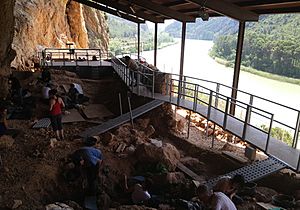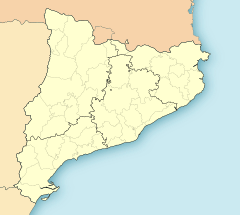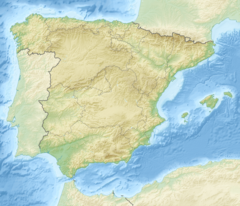Roca dels Bous (archaeological site) facts for kids
 |
|
| Alternative name | Bull's Rock |
|---|---|
| Location | Sant Llorenç de Montgai, Noguera county |
| Region | Province of Lleida Catalonia, Spain |
| Coordinates | 41°52′25″N 0°50′40″E / 41.873565°N 0.844551°E |
| Height | 286 m |
| History | |
| Periods | Middle Paleolithic |
| Associated with | Neanderthals |
| Site notes | |
| Website | Roca dels Bous |
Roca dels Bous (which means "Bull's Rock" in Catalan) is an important archaeological site. It is located in Sant Llorenç de Montgai, in the Catalan Pyrenees mountains in Spain. Since 1988, experts from the Autonomous University of Barcelona and the UCL Institute of Archaeology have been studying this site. They are learning about the Neanderthals who lived here about 50,000 years ago during the Middle Paleolithic period.
The team uses special digital systems and new technologies. These tools help them sort and understand the ancient objects they find. Roca dels Bous was one of the first Paleolithic sites in Spain to open a visitor center. This center helps people learn about the ancient history of the pre-Pyrenees area.
Contents
What is the History of the Roca dels Bous Site?
When did the Project Begin?
The Roca dels Bous site is about 6 kilometers (4 miles) north of Balaguer, in the Province of Lleida. It sits high above the river Segre, at 286 meters (938 feet) in the foothills of the Pyrenees.
The main goal of the project is to understand how Neanderthal groups lived. Researchers also want to find out why Neanderthals disappeared. They are also looking for signs of how Neanderthals and early modern humans might have interacted.
In 1973, a researcher named Emili Sunyer noted that there were signs of the Mousterian culture here. This culture is linked to Neanderthals. During excavations, archaeologists found tools made of flint and quartzite. These tools are typical of Middle Paleolithic Neanderthals.
What Did Neanderthals Eat?
The excavations reached a depth of about 1.5 meters (5 feet). In these layers, scientists found bones from many different animals. These animals were part of the Neanderthal diet. They found fossils of animals that lived in woodlands, like red deer. They also found bones from animals that lived in grasslands, like wild horses. Bones of animals that lived on rocks, like wild goats, were also discovered. This suggests that Roca dels Bous was a place where different types of environments met.
The small number of tools and animal remains found here suggests something interesting. There were also no continuous layers of ancient campfires. This means Roca dels Bous was likely a temporary shelter for small groups of hunters. It was probably not a place where they lived all the time. Researchers are now studying how Neanderthal movements depended on where their prey animals migrated. The site's central location was important. It allowed hunters to watch the seasonal movements of animals, especially horses and deer, between the Ebro Depression and the Pyrenees.
How is Research Done at Roca dels Bous?
What New Technologies are Used?
Research at Roca dels Bous started in 1988. This long period has helped scientists learn a lot about this important time in history. The European Union has helped develop the site into a museum. They also helped build special buildings that are not common at other ancient sites.
Roca dels Bous is part of a European project called POCTEFA. This project is a partnership between Spain, France, and Andorra. Its goal is to provide valuable information about Neanderthal life in this area. It also aims to understand why they suddenly disappeared.
A special digital system has been created to study Roca dels Bous. This system uses information about where objects are found and their surroundings. It helps during the process of finding and recording objects. For example, it helps create exact ideas about the site. It can also help find mistakes in how archaeological findings are understood.
Visiting the Archaeological Park
Roca dels Bous is the first archaeological site in Spain to have an interactive museum and exhibition. These are part of the Archaeological Park of Sant Llorenç de Montgai. Visitors can take interactive tours using photos, drawings, videos, maps, and 3D applications. Archaeologists use laser technology to record the exact spot where each finding is made.
Research teams also use an innovative digital system to classify the objects they find. They use Data Matrix codes in their fieldwork and small handheld computers (PDAs). This new method greatly reduces errors (from 40% to just 1%). It also cuts the time needed to label objects in half. This way of working is now being used in other archaeological projects across Europe.
Images for kids
See also
In Spanish: Roca dels Bous para niños




